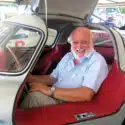Signed, sealed and reliveried
When I was wittering last month at bygone Formula 1 heroes for talking BS about use of illegal Formula 1 engines, a reader confessed he’d quite enjoyed the piece despite my “agonising detail”. That’s an inconvenience about attempting not only to establish the truth, but also to be seen to be doing so. It’s necessary to consider all evidence to the contrary.
And it’s pretty much the same in the car restoration business – if the restorer is applying adequate standards – and in model-making too. If it’s not spot-on – in detail – it’s wrong. Ten years ago, the late Phil Hill and I became co-presenters of the first car collector’s connoisseurship symposium, held at Miles Collier’s stupendous museum in Naples, Florida. The symposium has since become a biennial event, and in March, when Miles ran it for the sixth time, I was there gazing at his Porsche 550 Coupé in its Guatemalan livery, all dressed up as it had been for the 1953 Carrera Panamericana road race through Mexico. At this year’s Goodwood Festival of Speed we are running a Carrera class to celebrate the event’s 60th anniversary since it was first run in 1950. I had been lettering a participating Ferrari from that 1953 Carrera, and had therefore had my nose in the photo record. Since the Ferrari’s lengthened Spa/Carrera nose section has now been rebuilt into original 1953 Le Mans form there’s no way it can look right with accurate Carrera lettering re-applied, so we opted to provide a livery ‘typical of the period’.
Photos show little star-shaped patches on the door and bonnet edges of competing Carrera cars, and it has always been a pain to find adequate reference to what these really were.
The 1953 Carrera was run over five days and for the first time all-night work on the cars was banned. Instead, no longer than three hours after they had crossed the finish line of a day’s final stage, and had re-fuelled ready for the re-start next morning, the cars had to be deposited in a closely guarded parc fermé, further work prohibited. As a result, official seals were applied to the competing cars’ opening panels in the parcs fermé at Oaxaca, Mexico City, Durango and Chihuahua. These are the otherwise rather puzzling star-shaped patches (right) visible in many contemporary photographs.
The Collier Porsche 550 Coupé is chassis ‘01’ – which makes it in effect the very first example of a works Porsche designed specifically for racing. After Le Mans and the Carrera it lost its original Coupé body in favour of an open Spyder shell, but once acquired by the Collier Collection it was painstakingly restored to as near perfect 1953 Carrera form as could be achieved. Gazing at the car in Naples – it’s due at Goodwood so you can have a look there as well – I focused on these parc fermé door and bonnet seals. We could do with some for the Ricci/Maglioli Ferrari, and here was exactly what we needed.
The original seals were shaped as eight-pointed stars, lettered with the Mexican ‘Asociacion Nacional Automovilistica’ ANA crest, and lettered in Spanish ‘IV Carrera Panamericana 1953’, ‘Parque Cerrado de MEXICO’ and then, in capital letters ‘SELLADO’ – ‘sealed’. As a safeguard against predictably light-fingered racers’ ingenuity in nicking extra seals at the first overnight stop, the seals for each parc fermé were printed in a different colour. Mexican cunning, eh? The colours were, I believe, green, black, blue and red. Each successive night’s seal would be applied over its predecessor, and the officials commonly rotated them slightly, so the build-up by the last day of four eight-pointed stickers, one on top of the other, produced a multi-pointed star burst. The system seems to have worked pretty well – certainly too well for some embattled contenders, racing against the clock to cure leaks, splits, failing bearings, blowing valves and every other injury that the Panamerican Highway course could inflict.
Carrera ’53 regulations also made crash helmets compulsory for every driver, seat belts mandatory in closed cars but optional in convertibles and Spyders, and it was recommended that every competitor should carry a medical card announcing his blood group, drug intolerances and so on in case he had to be scraped up somewhere. Carrying alcohol on board was “specifically” forbidden – which perhaps tells its own story.
So 60 years ago even the freewheeling Carrera Panamericana had stringent rules. Of course once the flag dropped it was really the most brutal bare-knuckle fight, ultimately won by Fangio’s factory Lancia D24. The pugnacious little Porsche 550 Coupé, chassis ‘01’, driven by Jaroslav ‘Jerry’ Juhan – of later Lotus/DeLorean scandal celebrity – with the impressively named Antonio Asturias Hall alongside him, did not finish. And works Lancia driver Felice Bonetto was not alone in suffering a fatal accident…
The strongest of the Ferrari challengers had been a 375MM Spyder driven by Umberto Maglioli, but it had thrown a wheel on the Léon-Durango stage. Industrialist Mario Ricci then offered him a drive in his 375MM Berlinetta for the last three stages. The sister Berlinetta of Antonio Stagnoli/Giuseppe Scotuzzi had burst a tyre at 165mph on day one and had somersaulted, killing them both.
Regardless, Maglioli just ignored the risk of a similar tyre burst to win the Durango-Parral section in Ricci’s car at 111.5mph, then Parral-Chihuahua (186 miles) at 127.4mph. The local press dubbed him ‘Suicide at the Wheel’. And he then won the last stage from Chihuahua-Ciudad Juarez (222 miles) at 138.31mph. Car owner/passenger Ricci later recalled riding with Maglioli as having been “absolutely terrifying”. Perhaps he really could have found a use for an extra parc fermé seal?

